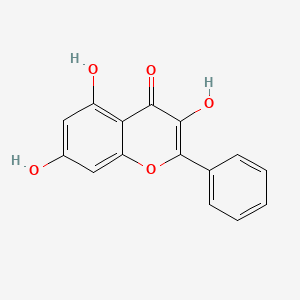Ferroptosis-centered Drug Response Information
General Information of the Drug (ID: ferrodrug0128)
| Name |
Galangin
|
||||
|---|---|---|---|---|---|
| Synonyms |
Galangin; 548-83-4; Norizalpinin; 3,5,7-Trihydroxyflavone; 3,5,7-Trihydroxy-2-phenyl-4H-chromen-4-one; 3,5,7-triOH-Flavone; 4H-1-Benzopyran-4-one, 3,5,7-trihydroxy-2-phenyl-; 3,5,7-Trihydroxy-2-phenyl-4-benzopyrone; 3,5,7-trihydroxy-2-phenylchromen-4-one; FLAVONE, 3,5,7-TRIHYDROXY-; NSC-407229; 4H-Benzopyran-4-one, 3,5,7-trihydroxy-2-phenyl-; NSC407229; 142FWE6ECS; CHEBI:5262; CHEMBL309490; 3,5,7-trihydroxy-2-phenyl-4H-benzopyran-4-one; TNP00099; 3,5,7-Trihydroxy-2-phenyl-4H-1-benzopyran-4-one; Norizalpinin;3,5,7-Trihydroxyflavone; 3,5,7-tris(oxidanyl)-2-phenyl-chromen-4-one; EINECS 208-960-4; MFCD00006833; UNII-142FWE6ECS; NSC 407229; BRN 0272179; teptochrysin; CCRIS 8471; Galangin,(S); 3,7-Trihydroxyflavone; 5,7-Dihydroxyflavonol; GALANGIN [INCI]; 3,5,7-trihydroxy-2-phenyl-chromen-4-one; GALANGIN [MI]; 3,5,7-Trihydroxy-Flavone; GTPL410; 5-18-04-00567 (Beilstein Handbook Reference); MLS002473087; SCHEMBL117225; MEGxp0_000533; ACon1_000977; cid_5281616; DTXSID70203288; HMS2268D24; EX-A4261; HY-N0382; BDBM50049391; LMPK12111653; s5529; Galangin, autophagy inducing flavonoid; AKOS003672546; AC-6383; AM85813; CCG-208629; CS-5619; NCGC00017220-01; NCGC00017220-02; NCGC00017220-03; NCGC00142457-01; NCGC00169794-01; AS-14766; SMR000112582; FT-0626589; G0370; A14607; 3,5,7-trihydroxy-2-phenyl-1-benzopyran-4-one; 3,5,7-Trihydroxy-2-phenyl-4H-chromen-4-one #; 4H-1-Benzopyran-4-one,5,7-trihydroxy-2-phenyl-; A830393; SR-05000002165; Q-100620; Q2456591; SR-05000002165-2; BRD-K16503581-001-01-5; BRD-K16503581-001-04-9; Z1980554245; 3,5,7-Trihydroxy-2-phenyl-4H-1-benzopyran-4-one, 9CI; 4H-1-Benzopyran-4-one, 3,5,7-trihydroxy-2-phenyl- (9CI)
Click to Show/Hide
|
||||
| Status |
Investigative
|
||||
| Drug Type |
Small molecular drug
|
||||
| Structure |
 |
||||
| Formula |
C15H10O5
|
||||
| IUPAC Name |
3,5,7-trihydroxy-2-phenylchromen-4-one
|
||||
| Canonical SMILES |
C1=CC=C(C=C1)C2=C(C(=O)C3=C(C=C(C=C3O2)O)O)O
|
||||
| InChI |
InChI=1S/C15H10O5/c16-9-6-10(17)12-11(7-9)20-15(14(19)13(12)18)8-4-2-1-3-5-8/h1-7,16-17,19H
|
||||
| InChIKey |
VCCRNZQBSJXYJD-UHFFFAOYSA-N
|
||||
| PubChem CID | |||||
| TTD Drug ID | |||||
Full List of Ferroptosis Target Related to This Drug
Cystine/glutamate transporter (SLC7A11)
| In total 1 item(s) under this Target | |||||
| Experiment 1 Reporting the Ferroptosis-centered Drug Act on This Target | [1] | ||||
| Target for Ferroptosis | Suppressor | ||||
| Responsed Disease | Cerebral ischemia | ICD-11: 8B10 | |||
| Pathway Response | Fatty acid metabolism | hsa01212 | |||
| Ferroptosis | hsa04216 | ||||
| Cell Process | Cell ferroptosis | ||||
| In Vitro Model | mHNs (Mouse hippocampal neurons) | ||||
| In Vivo Model |
Male gerbils weighing 70-90 g (12 weeks) were selected for this study. Gerbils were anesthetized with 7% chloral hydrate (350 mg/kg) and the bilateral common carotid arteries were occluded using artery clips. After 5 min, the clips were removed to restore cerebral blood flow. After the operation, place the gerbil on an electric blanket to keep the gerbil's body temperature. The sham group underwent the same surgical procedure without ligation of carotid arteries and was given an equal volume of physiological saline as in the treated groups. The model + galangin (Jiangsu Yongjian Pharmaceutical Technology, 548-83-4, Purity: >=98% (HPLC)) groups underwent the same procedure as the model group and then were received galangin at 25, 50, or 100 mg/kg/day for two continuous weeks.
Click to Show/Hide
|
||||
| Response regulation | Gerbils treated with galangin after ischemia-reperfusion (I/R) injury showed significant improvements in learning and memory. In addition, galangin treatment reduced the levels of lipid peroxide in the brains of gerbils that underwent I/R as well as reduced the amount of cell death and increased the expression of SLC7A11 and glutathione peroxidase 4 (GPX4). | ||||
